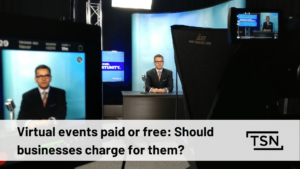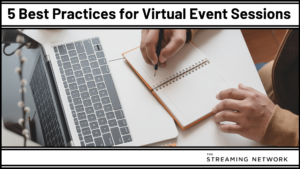In the last 12 months, the way we host events has evolved. With the onset of the Covid-19 pandemic and constraints of social distancing, companies pivoted away from in-person events towards the digital frontier. As with any new endeavour, many of them are still learning how to make a successful transition – a recent report found that 27% are struggling to understand how to encourage participants to attend a virtual event.
Well, we’re here to break down the ins and outs of hosting a virtual event, including the most common pitfalls, to make this a less daunting task.
A new set of rules
The biggest thing that people forget when planning and hosting a virtual event is that it’s digital. Businesses fall into the trap of trying to replicate an in-person experience. This is a mistake – online audiences have different mindsets and expectations.
To understand that difference, let’s compare how we shop in-person versus our online shopping habits. When we’re at a retail store, we tend to meander all over the place, hunting for what we want. The layout of the store is designed to accommodate this sort of behaviour.
On the other hand, when we’re online, we know exactly what we want and expect to be able to find it immediately. After comparing prices and checking reviews, we’re in and out of the website, with the product at our door soon after.
So how does this apple to digital events? When you’re planning one, you need to keep in mind that your audience is all over the place, geographically and in their needs. Instead of creating a one-size-fits-all solution, you want to tailor the experience so that everyone can get that what they want, as quickly as possible.
Criteria for a successful event
Unfortunately, there isn’t an all-encompassing definition of a ‘successful’ virtual event. The most common answer is that it worked tactically and attracted a lot of people. However, this only scratches the surface. What you really want to be doing is giving people the opportunity to engage with you, the presenter, as well as the content.
Think of a TV sports broadcast. There’s the game itself and all the other components that go into making a successful, captivating TV broadcast – the commentary, player interviews, half-time show and so on. How would you feel it all this pageantry was missing? No doubt, unless you’re a diehard fan, you’d lose interest very quickly.
A successful virtual event should have the following three elements:
- Engagement: Give your audience room to submit comments and questions. Don’t just talk at them.
- Choice: Let them choose how they engage with you and consume the content. Give them relevant takeaways and the option to stream live or on-demand, so that everyone can get something out of the experience.
- Fun: Just because you’re online doesn’t mean you have to be robotic. Add that human element to spice up the overall experience.
Figuring out the logistics
Some people believe that hosting a virtual event requires less preparation than a physical one. That’s simply not true. We’ve seen plenty of horror stories where mistakes drive away participants and hurt a company’s credibility.
First and foremost, you need to consider your audience. The people attending your virtual event are doing so because they don’t want to travel, are looking to save money or just enjoy the convenience (i.e., access to an archive to re-watch anything they miss). Moreover, Covid-19 has introduced many safety restrictions and individuals are hesitant to venture out for live events.
As such, you’ll need to create an incentive to hook them in. Unlike in-person events, where there are things like an after-party and hand shaking to look forward to, digital events consist of a solitary person at their laptop or desktop computer, and many distractions. Your focus should be to give them something of value like content or giveaways – white papers, case studies, certifications and so on.
You’ll also want to think about whether you even need an in-person event or will a streamed one suffice? Obviously, with the pandemic still raging, this decision has already been made for you; but as we inch our way back to ‘normal,’ this is something that your business needs to factor in. In some cases, virtual can be to your advantage. Even if someone attends in-person, there’s no way that they’ll absorb everything on offer. They’ll miss content and will need to review the stream.
And finally, determine how much of the event needs to be live. Depending on the type of content, you can create segments in advance and record it, cutting down on your preparation.
Getting a return on your investment
So, you have your attendees, but what does the ROI look like? How do you justify the costs of hosting against the bottom-line?
Well, once again, that’s going to be personalized and will vary from company to company. If this is an external-facing event for your customers and prospects, it’s about funneling leads to the sales pipeline. Conversely, if it’s internal-facing, meaning your employees and executives, you’re going to be looking for buy-in. See if the event improved morale, sparked employees to learn a relevant skill and so on.
When you’re judging the success of your event, you’ll also want to determine if you’re getting the right people. As mentioned before, there’s more to these events than getting them to work or having many viewers – on average, you’ll get 2 to 2.5x more attendees than a physical event. That’s just the bare minimum.
What you want to focus on as a business is encouraging quality engagement from your audience. Did you know that only 11% of webinar attendees ask questions? Depending on your end goal, you’ll want to give your audience the tools to immerse themselves in the experience. These can include:
- Q & A’s
- Polling
- Chat
After the event ends, you can have your audience further the conversation by sharing the content with others on all the social channels as well as inviting them to fill out a survey or download a handout. The person who engages throughout the event and is willing to download more materials after the fact, is a person who is sales-ready. If you’re in the business of making money, that’s ultimately what you’re looking for.
To charge or not to charge
One of the most common questions for businesses is whether they should charge a fee for virtual events. After all, there are associated costs , and they want people to value the offering. According to estimates, only half of the people who register for events show up.
It depends. What are you trying to accomplish? The idea of premium content is enticing. Psychologically, people tend to value things that they pay for more. Our numbers from several of our B2B conferences pre-pandemic support this theory, as paid live events consistently outperformed free live events in terms of engagement.
However, if the purpose of your offering is to generate leads for the sales team, you can get away with no fee.
The number one takeaway is this – always start with what the person behind the screen wants and you’ll be well on your way to a successful event.
If you need even more help hosting a great online event, the experts at The Streaming Network are passionate about helping clients stand out with compelling events that people want to attend. We have plenty of free resources on offer too. Reach out to us today to get started!






